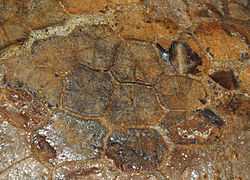Psephophorus
| Psephophorus Temporal range: Oligocene-Pliocene | |
|---|---|
 | |
| Shell | |
| Scientific classification | |
| Kingdom: | Animalia |
| Phylum: | Chordata |
| Class: | Sauropsida |
| Order: | Testudines |
| Suborder: | Cryptodira |
| Family: | Dermochelyidae |
| Genus: | †Psephophorus von Meyer, 1847 |
| Type species | |
| †P. polygonus[1] | |
| Species | |
| |
Psephophorus is an extinct genus of sea turtle that lived from the Oligocene to the Pliocene. Its remains have been found in Europe, Africa, North America, and New Zealand.[2] It was first named by Hermann von Meyer in 1847, and contains seven species, P. polygonus, P. calvertensis, P. eocaenus, P. oregonesis,[3] P. californiensis,[4] P. rupeliensis,[5] P. scaldii,[5] and a species discovered in 1995,[2][6] P. terrypratchetti.
Psephophorus is the only Miocene dermochelyid turtle found in Europe.[7] One species of Psephophorus could measure up to ten feet in length.[8]
Discovery and identification
Von Meyer originally called Psephophorus "Jahrbuch" in 1846. At first he was unable to identify the creature beyond its dermal plates, but when he later received a drawing he was able to describe the specimen, which was then in Pressburg, as a fragment of a carapace, which contained seventy bones.[1]
In 1879, Professor H.G. Seeley was asked to study the Psephophorus specimen by Franz Ritter von Hauer, the Director of the Austro-Hungarian Imperial and Royal Geological Survey.[1] Up until then, the specimen's identity had been undeterminable, with even Seeley describing it at first to seem like "the dermal covering of an Edentate closely allied to the Armadilloes."[1] Seeley examined some bone fragments and concluded the specimen was that of a reptilian creature,[1] furthermore a chelonid. It also proved to be more closely related to Sphargis than any other type in the Chelonian order.[1]
Relation to modern Leatherback sea turtles
For a long time, modern Leatherback sea turtles (Dermochelys) were believed to be descended directly from Psephophorus,[9] specifically the species P. polygonus.[10] However, a 1996 analysis by Wood et al. proved that most of the taxa in the two genera were not connected, meaning Psephophorus could not be a direct ancestor of the modern leatherbacks.[9] The platelets on Psephophorus are quite similar to those on Dermochelys, despite differences in outer morphology and size.[11] The platelet comprises an external compact layer and an internal zone of cancellous bone.[11]
Species
- Psephophorus polygonus is the type species, and was discovered by von Meyer in 1846.[1] Fossils of the species have shown bony, carapacial ridges, adjacent, small and polygonal bony ossicles which measure about 22 x 25 mm.[10] When the ossicles extend further along the longitudinal axis, their size increases up to an average of 33 x 41 mm.[10]
- Psephophorus calvertensis was first named by Palmer in 1909.[12] It was so named for being found in the Calvert Formation.[13] P. calvertensis is a rarely found specimen.[13]
- Psephophorus eocaenus was first named by Andrews in 1901.[14]
- Psephophorus californiensis was first named by Gilmore in 1937.[4]
- In 1995, Richard Köhler found a specimen of the Psephophorus genus in New Zealand, which proved to be different from the species which had been found in Europe, Egypt, and the United States.[2] It was then declared a new species altogether, and Köhler named the species Psephophorus terrypratchetti after the author Terry Pratchett, who wrote a series of fantasy books set on a world carried on the back of a giant turtle.[6][15]
See also
- List of animals named after celebrities
References
- ↑ 1.0 1.1 1.2 1.3 1.4 1.5 1.6 "Note on Psephophorus polygonus, v. Meyer, a new Type of Chelonian Reptile allied to the Leathery Turtle". Journal of the Geological Society, London, Legacy. 1880. Retrieved 2008-06-27.
- ↑ 2.0 2.1 2.2 "Köhler - A new species of Psephophorus". R. Köhler; Journal of The Royal Society of New Zealand. September 1995. Retrieved 2008-06-27.
- ↑ "The Oregon Fossil Guy". www.mailtribune.com. 2008-04-27. Retrieved 2008-06-28.
- ↑ 4.0 4.1 "Sharktooth Hill Fauna, circa 2003". Shark Tooth Hill.com (optionally viewed as a Microsoft Word document). 2003. Retrieved 2008-06-28.
- ↑ 5.0 5.1 Proceedings; page 8. By the Zoological Society of London; published 1891. Retrieved on June 28th, 2008.
- ↑ 6.0 6.1 "New Zealand species of Psephophorus". Everything2.com (partially derived from an interview with Terry Pratchett on The Discoworld Companion). 2001-11-01. Retrieved 2008-06-27.
- ↑ "New Remains of Psephophorus polygonus (Chelonii: Dermochelyidae) from the Miocene of Southern Italy". digilander.libero.it. 2004. Retrieved 2008-06-27.
- ↑ A Manual of Palaeontology; page 1091. By Henry Alleyne Nicholson and Richard Lydekker; published 1889, Blackwood. Retrieved on June 28th, 2008.
- ↑ 9.0 9.1 "Turtles of the World". nlbif.eti.uva.nl. Retrieved 2008-06-27.
- ↑ 10.0 10.1 10.2 "Fossil sea turtles (Chelonii, Dermochelyidae and Cheloniidae) from the Miocene of Pietra Leccese (late Burdigalian-early Messinian), Southern Italy". 2007. Retrieved 2008-06-27.
- ↑ 11.0 11.1 "Bone histological results of Testudinata". hss.ulb.uni-bonn.de. Retrieved 2008-06-27.
- ↑ "Psephophorus calvertensis at the Paleobiology Database.". paleodb.org. Retrieved 2008-06-27.
- ↑ 13.0 13.1 Journal of Paleontology; page 279. The Society of Economic Paleontologists and Mineralogists; published March 1974. Retrieved on June 27th, 2008.
- ↑ "Psephophorus eocaenus at the Paleobiology Database.". paleodb.org. Retrieved 2008-06-27.
- ↑ Curiosities of Biological Nomenclature
External links
Further reading
- Jack M. Callaway and Elizabeth L. Nicholls, Ancient Marine Reptiles.
- Nielsen, Eigil (1959) Eocene Turtles from Denmark. Bulletin of the Geological Society of Denmark 14 (2): 96-114.
- American Journal of Science; page 421. Edited by Benjamin Silliman; published Published 1900, Converse.
- The American Naturalist; page 933. By the American Society of Naturalists; published 1898.